Thymus Study guides, Revision notes & Summaries
Looking for the best study guides, study notes and summaries about Thymus? On this page you'll find 5611 study documents about Thymus.
Page 2 out of 5.611 results
Sort by
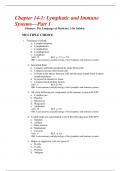
-
Test bank for medical terminology Chapter 14-1: Lymphatic and Immune Systems—Part 1 Chabner: The Language of Medicine, 11th Edition
- Exam (elaborations) • 26 pages • 2023
- Available in package deal
-
- £5.94
- 1x sold
- + learn more
TEST BANK FOR MEDICAL TERMINOLOGY SHORTCOURSE 11TH EDITION BY CHABNER Chapter 14-1: Lymphatic and Immune Systems—Part 1 Chabner: The Language of Medicine, 11th Edition MULTIPLE CHOICE 1. Formation of lymph: a. Lymphocytopenia b. Lymphadenitis c. Lymphedema d. Lymphopoiesis e. Lymphoid ANS: D REF: p. 571 | p. 574 OBJ: Learn anatomy and physiology of the lymphatic and immune systems. 2. Interstitial fluid: a. Contains antibodies produced by white blood cells b. Contains red ...
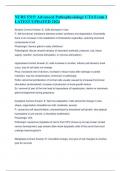
-
NURS 5315: Advanced Pathophysiology UTA Exam 1 LATEST UPDATED 2024
- Exam (elaborations) • 63 pages • 2024
- Available in package deal
-
- £10.06
- 2x sold
- + learn more
NURS 5315: Advanced Pathophysiology UTA Exam 1 LATEST UPDATED 2024 Atrophy Correct Answer: E. Cells decrease in size P. Still functional; imbalance between protein synthesis and degradation. Essentially there is an increase in the catabolism of intracellular organelles, reducing structural components of cell Physiologic: thymus gland in early childhood Pathological: disuse (muscle atrophy d/ decrease workload, pressure, use, blood supply, nutrition, hormonal stimulation, or nervous stimula...
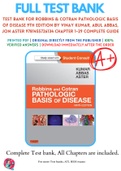
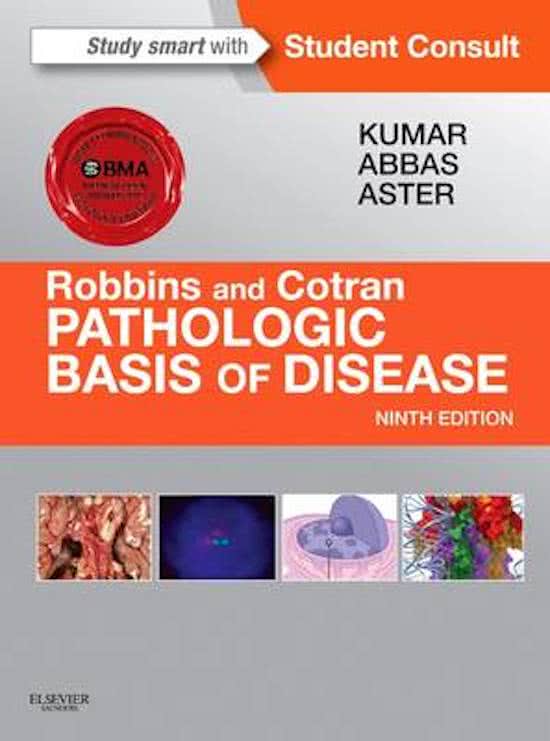
-
Test Bank For Robbins & Cotran Pathologic Basis of Disease 9th Edition By Vinay Kumar, Abul Abbas, Jon Aster 9781455726134 Chapter 1-29 Complete Guide .
- Exam (elaborations) • 155 pages • 2023
-
- £20.49
- 2x sold
- + learn more
Test Bank For Robbins & Cotran Pathologic Basis of Disease 9th Edition By Vinay Kumar, Abul Abbas, Jon Aster 6134, 3 . 6134, 3885, 6 1 The Cell as a Unit of Health and Disease 2 Cellular Responses to Stress and Toxic Insults: Adaptation, Injury, and Death 3 Inflammation and Repair 4 Hemodynamic Disorders, Thromboembolic Disease, and Shock 5 Genetic Disorders 6 Diseases of the Immune System 7 Neoplasia 8 Infectious Diseases 9 Environmental and Nutritional Diseases 10...
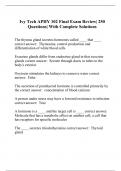
-
Ivy Tech APHY 102 Final Exam Review| 250 Questions| With Complete Solutions
- Exam (elaborations) • 31 pages • 2023
- Available in package deal
-
- £12.88
- 1x sold
- + learn more
The thymus gland secretes hormones called ____ that ____ correct answer: Thymosins; control production and differentiation of white blood cells Exocrine glands differ from endocrine gland in that exocrine glands correct answer: Secrete through ducts or tubes to the body's exterior Oxytocin stimulates the kidneys to conserve water correct answer: False The secretion of parathyroid hormone is controlled primarily by the correct answer: concentration of blood calcium A person under...
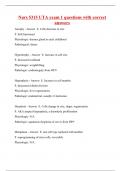
-
Nurs 5315 UTA exam 1 questions with correct answers
- Exam (elaborations) • 12 pages • 2023
- Available in package deal
-
- £11.67
- 1x sold
- + learn more
Atrophy - Answer E. Cells decrease in size P. Still functional Physiologic: thymus gland in early childhood Pathological: disuse Hypertrophy - Answer E. Increase in cell size P. Increased workload Physiologic: weightlifting Pathologic: cardiomegaly from HTN Hyperplasia - Answer E. Increase in cell number P. Increased cellular division Physiologic: liver regeneration Pathologic: endometrial- usually r/t hormones Dysplasia - Answer E. Cells change in size, shape, organizatio...
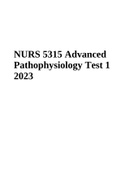
-
NURS 5315 Advanced Pathophysiology Test 1 2023
- Exam (elaborations) • 20 pages • 2023
-
- £22.14
- 4x sold
- + learn more
NURS 5315 Advanced Pathophysiology Test 1 2023. Decreases citric acid cycle production of NADH and leads to using Acetyl-CoA for ketogenesis and lipogenesis What can Reactive Oxygen Species cause? - ANSWER Heart disease, Alzheimers, Parkinsons, Amyotrophic Lateral Sclerosis (ALS), CV disease, HTN, HLD, DM, ischemic heart disease, HF, OSA. Lipid perioxidation, damage proteins, fragment DNA, less *protein synthesis*, chromatin destruction, damage mitochondria What is the body's defense agai...
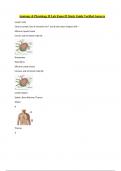
-
Anatomy & Physiology II Lab Exam #2 Study Guide Verified Answers
- Exam (elaborations) • 23 pages • 2024
- Available in package deal
-
- £8.05
- 1x sold
- + learn more
Anatomy & Physiology II Lab Exam #2 Study Guide Verified Answers Lymph node Cleanse Lymph; Site of activation for T and B cells; Bean-shaped; 450 + Afferent Lymph Vessel Convex side of lymph node (A) Brainpower Read More Efferent Lymph Vessel Concave side of lymph node (B) Lymph Organs Spleen, Bone Marrow, Thymus Spleen B Thymus A Pharyngeal Tonsil A Palatine Tonsil B Lingual Tonsil C Cervical Lymph Chain A Axillary Lymph Chain B Inguinal Lymph C...
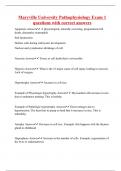
-
Maryville University Pathophysiology Exam 1 questions with correct answers
- Exam (elaborations) • 18 pages • 2023
-
- £10.46
- 1x sold
- + learn more
Apoptosis Answer A physiological, naturally occurring, programmed cell death, dismantles neutrophils Self destruction Deletes cells during embryonic development Nuclear and cytoplasmic shrinkage of cell. Necrosis Answer Tissue or cell death that is irriversible Hypoxia Answer What is the #1 major cause of cell injury leading to necrosis. Lack of oxygen. Hypertrophy Answer Increase in cell size Example of Physiologic hypertrophy Answer Myocardial cells increase in size due to endur...
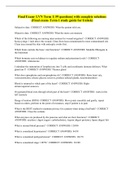
-
Final Exam- LVN Term 1| 59 questions| with complete solutions (Final exam- Term 1 study guide for Unitek)
- Exam (elaborations) • 4 pages • 2023
- Available in package deal
-
- £8.45
- 7x sold
- + learn more
Subjective data CORRECT ANSWERS: What the patient told you. Objective data CORRECT ANSWERS: What the nurse can measure Which of the following are nursing interventions for wound irrigation? CORRECT ANSWERS: Keep syringe 1 inch above the wound. Clean from least contaminated to most contaminated site. Clean area around the skin with antiseptic swabs first. Which brain controls the basic vital functions? CORRECT ANSWERS: Medulla Oblongata in the brainstem Which hormone acts on kidne...
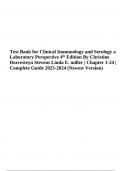
-
Test Bank for Clinical Immunology and Serology a Laboratory Perspective 4th Edition By Christine Dorresteyn Stevens Linda E. miller Chapter 1-24 Latest Guide 2023-2024
- Exam (elaborations) • 159 pages • 2023
-
- £23.75
- 1x sold
- + learn more
Test Bank for Clinical Immunology and Serology a Laboratory Perspective 4th Edition By Christine Dorresteyn Stevens Linda E. miller Chapter 1-24 Latest Guide 2023-2024. Which of the following is a characteristic of natural killer cells? A. They mature in the thymus. B. They are smaller than B and T cells. C. They are a type of lymphocyte. D. They are part of the adaptive immune system. ANS: C 5. Which of the following best describes diapedesis? A. Movement toward increasing concentrations...



